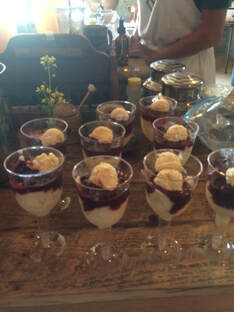|
|
 A Little More Culture in Your Life I am not sure if you have noticed a recurring theme throughout the dairy posts. Well, let me sum it up.
Is our cultured buttermilk the same as regular store bought buttermilk? In a word, no. Regular store buttermilk is made from whole milk and cultured with a dehydrated culture, usually thicker and sweeter than our cultured buttermilk which is made from our grass fed A2 heavy cream. At Diamond S, we culture it usually a full 24 hours for added digestibility, then chill it 24 hours, then bring it to the correct temperature to churn butter. (We have found 50 to 55 degrees is the perfect temperature.) This buttermilk is a bit more tart but makes wonderful pancakes. Scroll down to the end of this post to check out buttermilk pancakes with 3 variations to suit your fancy! Sometimes a few of the globules of the butter remain in our buttermilk. Cultured butter on the other hand is what we set out to make with heavy cream, our "liquid gold"! We culture the cream with a small amount of the buttermilk from the previous batch (if we have it) or a small amount of fresh kefir as our “starter” culture. The cultured buttermilk is strained off first then the butter is cleaned and packaged. Here's a great YouTube presentation you might like that walks you through this whole butter making process. Both cultured buttermilk and butter differ in taste, texture, and even appearance in some cases as opposed to regular buttermilk and butter. Both versions of buttermilk can be enjoyed in its natural state but is best known for use in recipes as a source of added nutrition. Cultured butter and regular butter also have similar uses in recipes or eaten regularly. Remember though, the added “culture” in dairy products adds tremendous nutritional benefit. Butter and more specifically cultured butter has been discovered to be a terrific addition to coffee in the morning! Check out this fun post on “bullet proof” coffee! This is Kris' go-to morning drink...only she of course uses our cultured butter. I also like this post from The Nourished Kitchen because it gives a good brief on cultured dairy products of all kinds and their use. FRIENDS! Guess what?? It's time to order! Yes it it's getting very close. We have three cows in the barn the last several very cold nights awaiting arrival of their new calves and they didn't disappoint! Meet Valentine, she's our newest arrival born February 14th! As always, dairy products are made according to the supply of the cows and demand of the customers. Contact us to learn more about our next batches of cultured dairy including buttermilk and butter. Buttermilk is best consumed quickly but butter can be ordered in bulk and frozen to be used throughout the year! Blessings! ~Diamond S
0 Comments
 Why Yogurt? Did you know that cultured dairy such as raw milk yogurt and cultured butter has the same probiotic benefits as lacto-fermented veggies such as real sauerkraut?? AND it has all the added benefits of preformed vitamin A, beta carotene, vitamin K2 and CLA that is found in dairy! Pictured here is lemon yogurt topped with berry/honey combination and creme fraiche on top. A wonderful desert . We have explored Raw Milk and Kefir in earlier posts. While yogurt is similar in benefits as kefir, it still has its unique uses and health reasons for consuming it and also has a flexibility in its use above and beyond the raw milk and kefir. Let's explore yogurt a little more. Yogurt is made from milk and a “starter” culture and brags of being a super-food full of live probiotics, good calories, and being high in protein as well as rich in vitamin A and calcium. These provide benefits for the entire body from the skin to your gastrointestinal tract to your bones. Not to mention, great on your taste buds! Why is yogurt made from raw milk better than pasteurized milk yogurt from the store? As with anything, you know your source of the milk. It is pure, clean, and healthy! Can you say the same for the dairy products at your local grocery store? In addition to that, raw milk yogurt tends to be richer and have a more diverse array of beneficial bacteria than that from pasteurized milk. Yogurt probiotics are in their most natural and digestible state. How does Diamond S make yogurt? By now you may have read a few articles about making yogurt from raw milk and you’ve probably found that there are about as many ways and theories of making yogurt as there are beneficial elements in it (millions). And everyone has to find the way that works for them. We think Diamond S has found our groove with yogurt and it’s a tasty groove, for sure! We have made and sold everything from plain and vanilla yogurt to entire parfaits with organic fruit and homemade granola! Yum! Not a fan of yogurt but want the benefits? Yogurt holds a unique ability to not only be consumed in its natural state but can be used/disguised in many other recipes. We talked in a previous post about how kefir can be used in smoothies, popsicles, and more. Well, so can yogurt. It can even help thicken and preserve homemade mayo! In addition to the above ideas, yogurt is high in lactic acid which is key in pre digesting grains by means of soaking them in recipes to reduce the amount of phytic acid in the foods you eat. To learn move about this and why you should sprout or soak the grains, nuts, and legumes you eat, check out these two web pages.
Intrigued and ready to enjoy some yogurt? Contact Diamond S to see when the next batch of plain, fruit or lemon yogurt will be available. Blessings,
~Diamond S P.S. Get ready for a little "culture", our next blog is about cultured milk! |
Categories
All
Archives
July 2024
|
|
Diamond S Ranch | PO Box 18, Hyattville, Wyoming 82428 | 307-469-2204 or 307-272-5334 text | [email protected]
|
 RSS Feed
RSS Feed